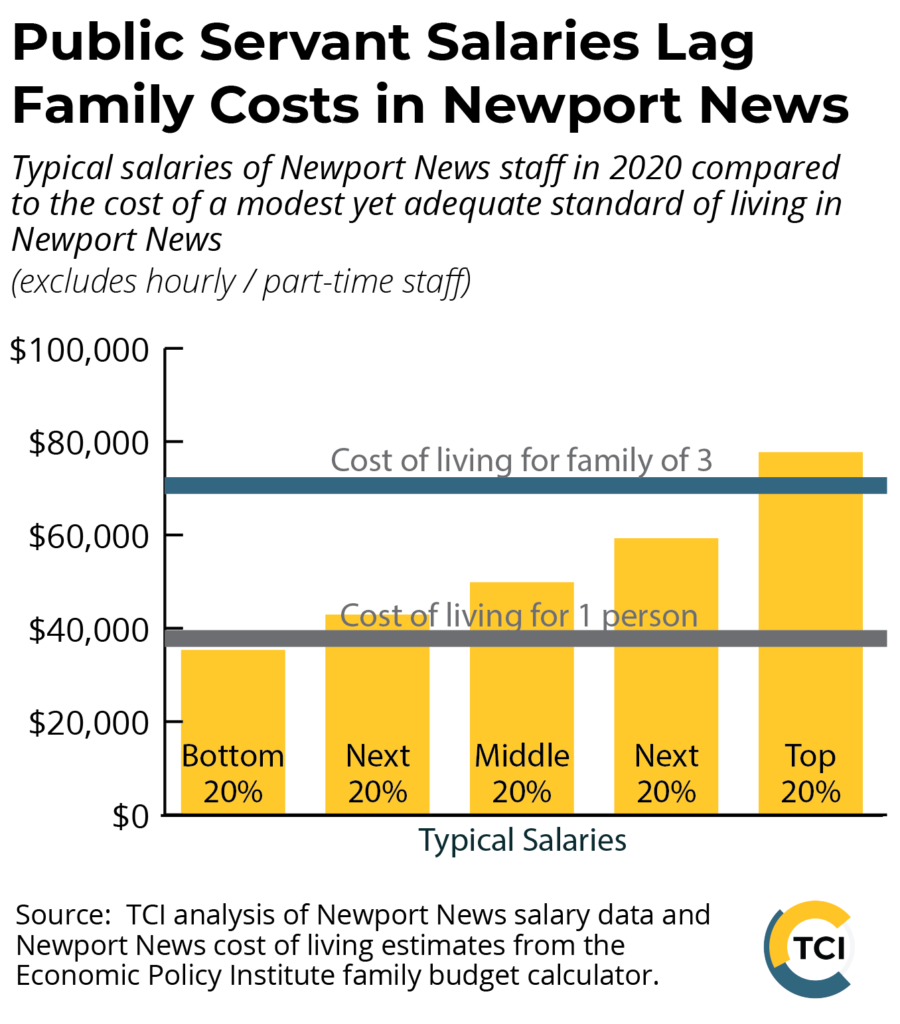October 25, 2021
Prioritizing Public Workers: How Collective Bargaining Can Help Public Employees in Newport News Achieve an Equitable and Quality Workplace
Newport News is a diverse community filled with rich and unique history. The city is working to transform into a community where people can thrive, but city officials cannot do it alone. Public employees are essential to providing the services and resources necessary for the city to function, and they play an integral role in the city achieving its goals. Allowing collective bargaining for city employees will provide them an opportunity to advocate for improving public services and building a more equitable community. In the end, that benefits every one of us.

“One of my main concerns is that while the city wants to call us essential workers, they don’t want us to have a say in our working conditions or our pay. I’m helping to build this Union because we as workers can fight for better pay and working conditions when we stand together!”
Riccretia Clifton | Department of Public Works, Equipment Operator, Solid Waste City of Newport NewsPublic employees in Virginia are currently underpaid

- Many local public employees in Newport News cannot afford to live in the city they serve.1 Right now, a single employee would need to make $37,793 to afford the city’s standard of living, yet 1 in 6 full-time city employees is paid less than that amount. Having a child raises that amount to $57,147 and having two children increases the cost of living to $70,584. Five out of every 6 full-time city employees make less than that amount.
- When we analyze non-managerial employees in key front-line departments (general services, human services, libraries, parks/recreation/tourism, vehicle and equipment services, and waterworks), we see that even fewer are paid enough to support themselves or a family. More than 1 in 4 of non-managerial employees make below the minimum cost to maintain a basic yet decent quality of life in Newport News for an individual, and 9 in 10 cannot afford to live and raise a family in the community where they work.
- Local public employees in Virginia are typically paid 29.9% less than their private-sector peers with similar levels of education, age, and hours worked, one of the largest pay penalties in the country.
- Pension and health care benefits do not make up for these pay penalties. Employee benefits for local public employees in Virginia are less generous than in other parts of the country, and many private-sector employees, particularly full-time employees of large companies, receive generous benefits. For Virginia as a whole, the estimated total compensation penalty for local employees compared to their private-sector peers is 28.0%, close to the pay penalty of 29.9%.2
Collective bargaining promotes pay equity
For public employees, one of the benefits of unions is increasing pay to levels that are closer to that which could be obtained in the private sector. Overall, public-sector collective bargaining tends to boost pay by 5% to 8%,3 and the fair and clear standards provided by unionization particularly help Black and Latinx workers.4 Women, who make up the majority of local government workers (especially in Virginia), would also particularly benefit from collective bargaining. This is important because past discrimination and ongoing barriers mean Black workers, Latinx workers, and women of all races are still typically paid less than white men with the same level of education and experience in both public- and private-sector employment.
Having the right to collectively bargain over pay and working conditions shrinks public-sector pay penalties, although it does not eliminate them. In Virginia, where until recently public-sector collective bargaining was totally banned, local government employees are typically paid 29.9% less than their private-sector counterparts with similar education and experience. In states that have a policy like Virginia’s new law that allows but does not require localities to permit employees to collectively bargain, the average pay penalty for local employees compared to their private-sector peers was 16.6%, and where collective bargaining rights are fully protected by state law the pay penalty was a smaller 10.5%.5

“We are losing workers. We want a seat at the table. We want the city to invest in us, just like they invest in equipment. There are these neighborhoods and infrastructure to maintain, and we do that work. I feel bad that I cannot find suitable housing in Newport News because I cannot afford it.”
Keith Graham | Department of Public Works, Stormwater, Construction & Maintenance Worker, Senior City of Newport NewsSince women and Black people are more likely to choose public service jobs, addressing pay penalties for public employees will reduce the broader problem of women and Black people being paid less than their peers with similar levels of education and experience.
Given the particular importance of unions in raising pay for those who for too many years have been underpaid compared to their levels of experience and education, it is not surprising that anti-union laws throughout the south were passed using explicit appeals to racist ideas. Undoing that legacy will require proactive steps to create more equitable policies and workplaces.
Having a union provides a voice in the workplace and the community
Although City Council recently approved a 3% raise for employees, this is less than the current inflation rate, leading to salaries eroding compared to the rising cost of living. A union can advocate for employees to receive more adequate increases. They can make sure that management and non-management staff are receiving adequate, livable wages that will amplify workers’ ability to live in the community they serve. The impact of unions is not just on pay and benefits. Collective bargaining provides a way for represented workers to formally express their ideas for how to improve their workflow and workplaces. This can improve communication and a sense of belonging. Having the experience of collective bargaining and union representation in the workplace even makes people — particularly younger people and those with less formal education — more likely to participate in other systems of democratic governance such as voting.6
Endnotes
- TCI analysis of 2021 salary data and EPI family budget calculator for a family of three.
- Morrissey, M., “Unions can reduce the public-sector pay gap: Collective bargaining rights and local government workers,” Economic Policy Institute, Jun 2021
- Brunner, E., and Ju, A., “State Collective Bargaining Laws and Public-Sector Pay,” ILR Review, Mar 2019
- McNicholas, C. et al, “Why unions are good for workers—especially in a crisis like COVID-19,” Economic Policy Institute, Aug 2020
- Morrissey, M., “Unions can reduce the public-sector pay gap: Collective bargaining rights and local government workers,” Economic Policy Institute, Jun 2021. This analysis used data from 2015 to 2019, before the state of Virginia permitted local governments to collectively bargain with their employees.
- Bryson, A., Gomez, R., Kretschmer, T., and Willman, P., “Workplace voice and civic engagement: what theory and data tell us about unions and their relationship to the democratic process,” Osgoode Hall Law Journal, 2013


